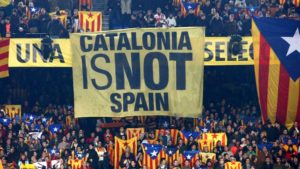
By Katherine Coble || News Editor
The drama in Catalonia continues to unfold as the Spanish prime minister, Mariano Rajoy, announced the firing of Catalonia’s regional police chief on Saturday morning. This is the latest in a series of incidents marking Spain’s worst political crisis since the 1970s.
Catalonia is a region in the far northeastern sector of the Iberian Peninsula. It is culturally and linguistically separate from the rest of Spain and its people have expressed nationalist ideas for centuries. During Spain’s time as a fascist state in the early 1900s, these ideas were heavily restricted by the Spanish government, but Catalonia has received increased political autonomy since the country transitioned to a democracy in the mid-1970s. It is an economically valuable region of Spain as well as one of the most populous; its capital Barcelona is the second biggest city in Spain and the sixth most populous urban area in the European Union.
In 2014, a referendum held in the state indicated that 80% of voters desired Catalonian independence. In the following year Catalan lawmakers composed a plan to secede from the Kingdom of Spain. Although federal courts suspended the plan, the Catalan government insisted they would proceed with secession. The most recent issues emerged in June of 2017, when Catalan leaders announced a new referendum on independence. Prior to the planned vote, the Spanish Civil Guard began raiding offices and detaining Catalan officials, facing large protests while doing so.
On October 1, 2017, the vote went forward despite being labelled illegal by Spanish federal courts. The referendum was marred by protests, violence, and accusations of Spanish police suppressing votes by shutting down polling stations. 93% of participants voted in favor of Catalonia becoming an independent republic, with a participation rate of 43%. Critics of the referendum insist this participation rate is too low (for reference, 73.2% of Spaniards participated in the country’s 2015 general election.) Those favoring Catalan independence argue in turn that participation would have been higher without police suppression.
Ten days after the controversial referendum, Catalan regional president Carles Puigdemont signed a declaration of independence. On Friday, October 27, the Catalan parliament officially voted to declare independence, leading to celebrations in the streets of Barcelona among Catalan nationalists. The Spanish government has responded by invoking Article 155 of the 1978 Spanish Constitution. Article 155 has been described as the “nuclear option” for the Spanish government and has never been used before. It allows the Spanish federal government to intervene in the operation of a regional government if that region “fails to fulfill the obligations imposed upon it by the Constitution or other laws, or acts in a way seriously prejudicing the general interests of Spain.”
Spanish Prime Minister Mariano Rajoy announced later on October 27 that he was firing Carles Puigdemont and his entire cabinet. He also dissolved the Catalan parliament and fired the regional police chief. Thus, the federal government of Spain is imposing direct rule over the Catalan state. This has led to security concerns, with onlookers worried about more violence breaking out as Catalan officials are forced to abandon their positions.
The Catalan remains unrecognized by the international community, with countries including the United Kingdom and the United States releasing statements saying they would not recognize Catalonia as an independent state. The European Union additionally came out against the independence movement, expressing concern regarding potential independence movements in other member states. If Catalonia does manage to establish international recognition of its independence, it will have to apply to join the European Union separately if it wishes to join the community.
Sophomore Katherine Coble is the news editor. Her email is kcoble@fandm.edu.